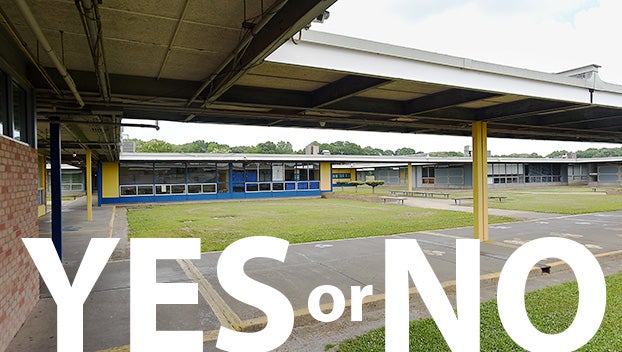Local leaders discuss support, reservations for school bond referendum
Published 1:26 am Sunday, May 21, 2017
NATCHEZ — Adams County voters will decide Tuesday on a $35 million bond issue for building a new school and renovating others that some have said could be the most important decision facing the community in several decades.
On one side, Natchez-Adams School District officials and others in the community have said updated schools could lead to better performance, improve student safety, increase property values and make the area more attractive to prospective businesses.
However, some community leaders and taxpayers have said they worry the increased tax burden could hurt local businesses, perhaps cost the area some jobs as small businesses have to cut back and could hurt residents paying taxes.
Financing
The district is hoping to spend approximately $44 million in total on a building program that would place a new high school in the bean field next to the current high school, renovate Natchez High School, Morgantown Middle School and McLaurin Elementary School.
School board members have not approved a final plan for renovations, but many have said they are on board with at least building a new high school.
The district’s plans include building a new high school for approximately $24 million, renovating the old high school into a middle school for approximately $17 million, renovating Morgantown for approximately $2 million and renovating McLaurin for approximately $845,000.
The figure in addition to the $35 million would be paid for internally by the district, through 16th section interest revenues and would also include funds currently paying for bonds that are scheduled to be retired over the next two years.
The amount in taxes a resident would pay depends on the interest rate the district receives and the county’s growth rate.
School projections for the millage increase use an assumed 1- to 1.5-percent growth in assessed value and an interest rate of 3.5 to 4.25 percent.
The county averaged a 3 percent assessed value growth rate over the past five years, the district’s financial advisor for the project has said.
County leaders have previously said 2017 looks to be a good year, with Von Drehle, a $7 million personal residence and more than 25 new houses at Beau Pre Country Club going on the tax rolls. An increased growth rate would ease the tax burden for all county residents.
Using last year’s assessed values, the millage increase ranges from 8.8 to 9.9 mills levied.
On the high end, assuming a 1-percent growth and an interest rate of 4.25 percent, the owner of a $100,000 assessed value residence would pay $99 more in taxes each year, using the 9.9-mill rate. The additional tax on a $15,000 car would be $45.55.
On the low end, assuming a 1.5-percent growth and an interest rate of 3.5 percent, the annual tax cost for a $100,000 assessed value residence would be $88 on 8.8 mills levied. The annual cost on a $15,000 car would be $39.60.
NASD Superintendent Fred Butcher has said the cost would be less than 40 cents per day.
The tax increase could be over the life of the bond, which is restricted to a 20-year maximum.
Based on a 20-year term at the 4.25-percent interest rate, the $35 million bond issue could end up costing taxpayers up to approximately $55.7 million.
The reasons to build
School board member Phillip West said he understands a tax increase is not a popular decision, but sometimes leaders have to bite the bullet and do what is in the best interest of the community.
While West said improvement would not occur overnight, better schools would lead to better performance and improve the entire community.
West said good schools lay a foundation for community safety.
“Young folks who are committing crimes, most of them dropped out of school,” West said. “They have no certifications, no skills and are on the wrong track.”
One reason West said he believes student performance would improve is because highly qualified teachers would be more likely to come work for the district.
“Teachers are the key,” West said. “Having good facilities gives us better opportunities to acquire competent and first-class teachers. That’s our real need, to have people wanting to work in the public school system in Natchez.”
West said he was recently at a conference in Jackson in which former Mississippi Economic Council President and CEO Blake Wilson spoke.
“He got up and talked about how important it was for a community to invest in education,” West said.
West said he realizes the tax burden could hurt those who own the most in the county, however, he said when the schools improve property values, those same people would also have gains.
“Education is key,” West said. “With all the unique things this community has to sell, to have a top-notch public education system, with top-notch facilities, we would be a town that a lot of people would be looking at and praising. We could have a real gem.”
District 3 Supervisor Angela Hutchins said having been to visit the schools and talk to the children, one of the big talking points the students had was about the conditions of the facilities. Hutchins said she believed for many students, an improved environment could help.
“You learn more when you are in a better environment,” Hutchins said. “It would make a difference if they were in a better environment, they would feel good about where they are going to school.”
Supervisor Ricky Gray said he worries a no vote would send a bad message to the rest of the state about where Natchez’s priorities are.
“If my daughter was still here and going to Cathedral, I would still be 100 percent for building new (public) schools,” Gray said. “It’s not about my daughter, it’s about the whole community.
“If we are going to get this community where we need to get it like we all like to say, we have to find a way to do what is best for the entire community and build new schools.”
Gray said voting no on the schools would send a bad message to business prospects and make the job of supervisors and economic development leaders more difficult.
Gray said the infrastructure in the school buildings limits what instructors can do.
“If we are going to live in Natchez, Mississippi, then we have to do what is best for the entire community, and that is to move forward,” Gray said. “It is the only way to move into the 21st century.”
Gray also said the safety aspect of some of the schools — which are open campuses and allow for intruders to enter from any angle — is as important an argument as improved test scores.
“People always tie test scores to building a new school,” Gray said. “To me, it is the wrong thing to tie to building a new school.
“I’m not saying it is going to improve test scores, though I think it will, but I am saying building a new school will have an impact on bringing the community to where it needs to be.”
An example Gray had for bringing the community forward would be some private school parents could be more likely to consider the public schools. Gray said public schools are able to offer program options many private schools are unable to offer.
Other options and the final word from district leadership
District 2 Supervisor David Carter said he agrees the district needs new schools, but rather than try to spend approximately $44 million at one time, he wonders why the district did not consider just building the new high school.
Then, maybe five years later, jump on another project.
Carter said the comparisons the district often brings up — Desoto County, Pearl and the Gulf Coast — that have built new schools recently are not good comparisons to Natchez. Carter said these locations saw population and economic growth before the new schools were built.
Natchez has not had the population or economic growth some of these areas have seen.
NASD Public Relations Coordinator Steven Richardson said the community has arrived at the point in which the job market and college demands have outpaced the facilities in the district.
“We cannot let the aforementioned communities outpace us as Natchez and Adams County historically have been known to be leading communities in education, industry, and a quality of life as a whole,” Richardson said. “When the community invests in education, it invests in good jobs, an increase in property value and reduced crime. People even will return to Natchez and Adams County when they see these important factors improve. Natchez/Adams County is a special place, a great community to live, work and play, and we want to further prove it by investing in our public schools.”
Maintenance costs are also through the roof in the district, exceeding $500,000 per year, and they are expected to rise due to failing air conditioners, plumbing and leaky roofs, Richardson said.
“We continue to fix on old buildings, but a homeowner cannot continue to make repairs to home without replacing those repaired items eventually,” Richardson said. “We can reduce the maintenance bill tremendously if we build and renovate thus saving taxpayers more money.”
Carter also expressed concerns about buildings that will no longer serve as schools ending up dilapidated, abandoned structures such as the former Washington School.
Officials have said they plan to maintain the schools that would no longer be used as schools and allow them to be utilized for various community needs and organizations. On the current plan, Robert Lewis Magnet School, Frazier Elementary School and the current Natchez Freshman Academy would no longer serve as schools.
Previously, Ward 1 Alderwoman Joyce Arceneaux-Mathis had voiced concerns with the plan due to Frazier and Robert Lewis not receiving renovations. However, she said Friday she plans to vote yes Tuesday.
Arceneaux-Mathis said the biggest problem in the district is Natchez High School.
“I worked out there,” Arceneaux-Mathis said. “It is a very unsafe school. It is too open.
“In the era that we live in, there are things going on in campuses around the country. It is time for us to do something about that school.”
Richardson said Natchez and Adams County are at a crossroad for public school education. Richardson said the district’s expectations remain high for students to pass, as well as any “A” district in the state.
“However, if you look at the “A” districts, the physical and technology infrastructure are sound, offering students learning environments and tools that prepare them for 21st century careers,” Richardson said. “We cannot keep giving our children the same and expecting a different result. All state testing is now on computers, but we do not have enough computer labs in which to test students.”
Science labs and STEM opportunities are also lacking in the district. Updated facilities would give the district opportunities to improve options.
“Robotics is huge in industries today such as with the Nissan and Toyota plants right here in Mississippi,” Richardson said. “We could prepare our students to get jobs right away in those plants upon graduation and any other automation plants that locate in Adams County if we add robotics labs to our new and renovated facilities.”
Expanded vocational options are also included, including welding, culinary arts, plumbing and perhaps cosmetology.
Richardson said the district is ready to work hard to improve the community.
“We want the community to know that if it passes this bond on Tuesday, we are coming back to the business and residential communities to find out exactly what the members would like to see in these new and renovated buildings,” he said. “We want the community to continue guiding our plans as we build and renovate facilities to meet the needs of this community.”






